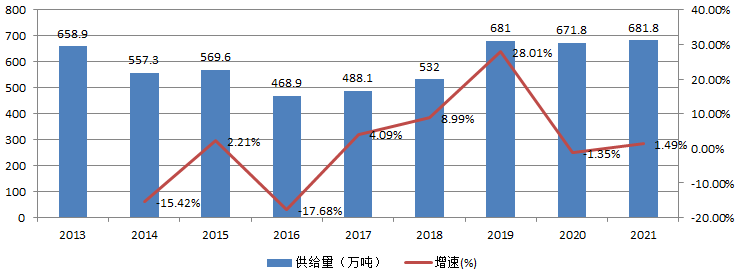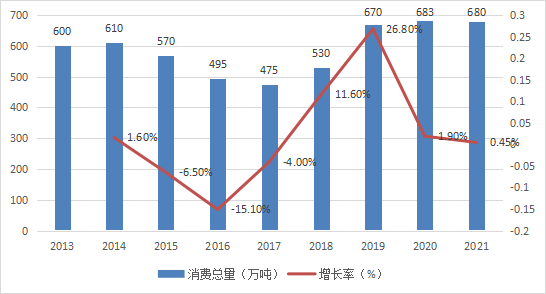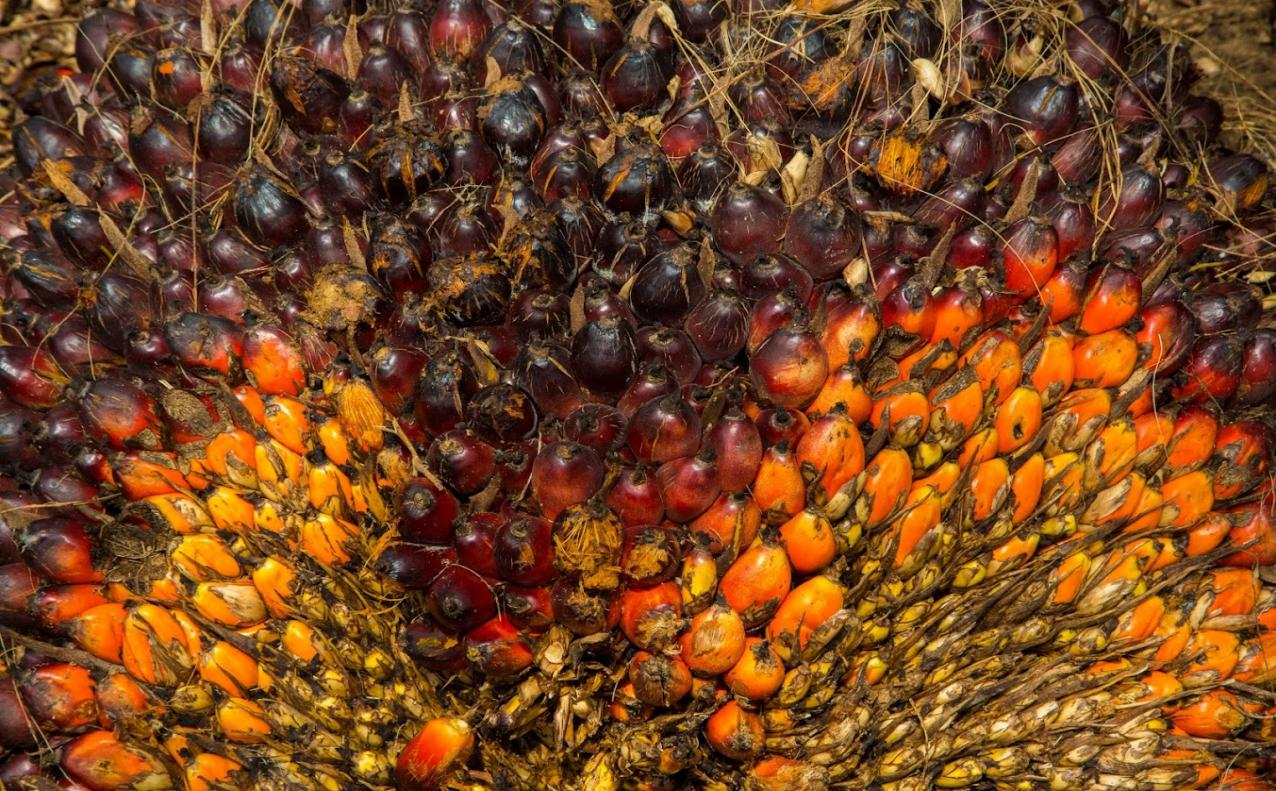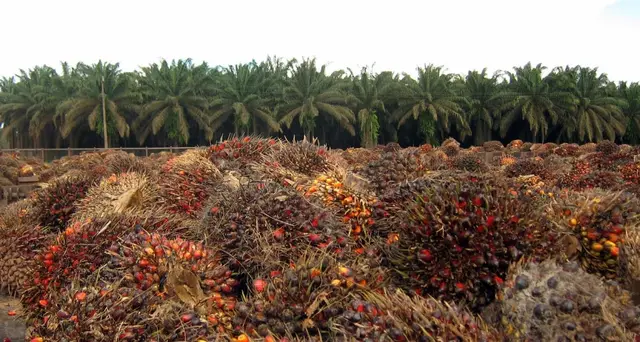Abstract: China plays an important role and actively contributes to the development of sustainable palm oil. This article aims to propose referenceable policies for sustainable palm oil in China. Based on an analysis of the supply, demand, and current cultivation of palm oil in China, the paper further examines the current state of sustainable palm oil in the country. It focuses on analyzing the international and domestic institutional construction and implementation of sustainable palm oil in China. Building upon the current implementation status, the challenges faced by sustainable palm oil in China are summarized. Finally, strategic recommendations are provided for consideration from the perspectives of public platform construction, certification, local cultivation, and international cooperation.
Key words: China;Sustainable Palm Oil;Policy
1 Introduction
China is the world's second largest importer of palm oil and the third largest consumer of palm oil, with an annual consumption of more than 6.5 million tons. In recent years, China's influence in the global palm oil value chain has been increasing. China's attitude and policies towards sustainable palm oil are having a significant impact worldwideand are of great significance for promotingsustainable palm oil production and trade globally in future.
2. The status of palm oil supply and demand in China
2.1 Palm oil supply status in China
China's palm oil supply is 100% reliant on imports, making it the world's second largest importer of palm oil. As shown in Figure 1, from 2013-2021, China's palm oil supply ranged from a minimum of 4.689 million tons (in 2016) to a maximum of 6.818 million tons (in 2021). China's palm oil supply is mainly distributed in the areas around the import port. There are mainly three regions: North China (around Tianjin and Shandong), East China (Zhangjiagang, Taixing, Ningbo and other surrounding areas of Shanghai), and South China (Huangpu, Shenzhen and other surrounding areas of Guangzhou). Palm oil imports in the three major regions account for 92% of the national total imports, of which north China accounts for 24%, East China for 34% and South China for 34%. At present, there are thousands of palm oil processing enterprises (refining, extraction and blending) in China。There are over 50 palm oil processing companies of a significant scale.

Figure 1 China: 2013-2021 (10,000 tons)
Source: National Grain and Oil Information Center for collation
2.2 Palm oil consumption in China
China is the world's third largest consumer of palm oil with an average annual consumption of over 6.5 million tons in the past three years. Palm oil consumption in China from 2013 to 2021 is shown in Figure 2. Palm oil consumption in China is mainly for edible and industrial use. Edible palm oil accounts for 70% and is primarily used in frying oils (such as instant noodles), baking oils, and confectionery fats. Industrial palm oil accounts for 30% and is used in non-food industries such as cosmetics, surfactants, and detergents.. There are 5,000 palm oil consumer enterprises of various types in China, mainly in the catering, food processing and chemical sectors. Among them, there are more than 1,000 palm oil consumption enterprises of significant scale. The representative consumers of edible palm oil mainly include Unified Food Group, Dingxin Group; industrial palm oil mainly includes Guangzhou Procter & Gamble Co., Ltd., NICE Yiyang Co., Ltd., Liby Group, Unilever, etc. Most consumer companies usually rely on intermediaries for palm oil supply.. There are about 50 consumer enterprises directly, accounting for about 4% of the total imports. Overall, approximately 80% of imported palm oil is used in commercial circulation, while about 20% directly enters end-consumption, toll processing trade, or bonded warehouse re-export activities.

Figure 2 Total Consumption and Growth rate of Palm oil in China: 2013-2021 (10,000 tons)
Data source: National Grain and Oil Information Center
2.3 Oil Palm cultivation in China
China's oil palm cultivation has a long history, but it has experienced challenges. The earliest cultivation began in 1926, and there have been two rounds of large-scale planting.. The first round took place in the 1950s to 1970s when the oil palm industry was elevated to a national strategy to address severe edible oil shortages. However, due to management and variety issues, this round ended in failure. The second round of large-scale planting occurred in the 1980s to 1990s but was discontinued due to poor economic returns. Currently, oil palm is mainly cultivated as an ornamental plant in 32 cities (prefectures) across four southern provinces, covering a vast area of approximately 256,100 square kilometers.. Drawing from the experiences and lessons learned from the previous two rounds of large-scale cultivation, China has made significant breakthroughs in oil palm varieties and cultivation techniques. The Rubber Institute of China Academy of Thermal Sciences has built the largest oil palm germplasm resource nursery with the largest area and the most abundant variety resources in China, with a total area of 660 mu. At the same time, the "Hot Oil 6" with an annual oil yieldof 200 kg / mu was cultivated, and field trials have commenced.. However, two main factors hinder large-scale oil palm cultivation in China. Firstly, labor costs are higher compared to Indonesia and Malaysia, approximately 2-3 times higher than Malaysia. Secondly, there are limitations in land resources, making it difficult to achieve large-scale planting and achieve economies of scale.
3. Current status of sustainable palm oil in China
3.1 Coordination of the international system of sustainable palm oil in China
China has signed a series of international agreements to provide a basic guarantee for sustainable palm oil. Such as in the United Nations on the environment and development conference, China signed five important documents, The Rio Declaration on Environment Development , Agenda 21, the Non-Legally Binding Authoritative Statement of Principles on All Types of Forests, Framework Convention on Climate Change, the Convention on Biological Diversity, Johannesburg, Plan of Action of the World Summit on Sustainable Development, etc. China has participated in the Glasgow Leaders' Declaration on Forests and Land Use, promising to halt and reverse deforestation by 2030, including forest damage due to palm oil cultivation. China has also reached a joint declaration with the United States and the European Union to support the elimination of global illegal deforestation.
3.2 Domestic institutional framework for the implementation of sustainable palm oil
The implementation of sustainable palm oil in China has a good institutional environment. The Chinese government attaches great importance to ecological progress, raising ecological progress to an unprecedented strategic height and incorporating it into the five-sphere integrated overall plan for the cause of socialism with Chinese characteristics, and calls for efforts to build a beautiful China and achieve sustainable development of the Chinese nation.[Xi Jinping: " We want not only clear waters and green mountains, but also mountains of gold and silver. Better want clear waters and green mountains than gold and silver mountains, and clear waters and green mountains are gold and silver mountains.”
The "two mountains" theory proposed by Chinese leaders echoes the concept of sustainable palm oil. The government issued the Opinions on Accelerating the Construction of Ecological Civilization and the Overall Plan for the Reform of the System for Ecological Civilization, which clarified the concept and goals of green development, emphasized the basic strategy of harmonious coexistence between man and nature, and proposed the commitment to achieving carbon peak and carbon neutrality, as well as the goal of stopping and reversing deforestation. China's Progress Report on the Implementation of the 2030 Agenda for Sustainable Development (2021) points out that the 14th Five-Year Plan and 2035 clearly require the in-depth implementation of the strategy of sustainable development and promote the comprehensive green transformation of economic and social development. It provides a legal basis and institutional guarantee to promote the development of sustainable palm oil. In the Work report of the Chinese Government in 2023, "Promote green and low-carbon development; promote green transformation of development mode; and improve policies and financial instruments to support green development". The introduction of the "Dual Carbon" target represents a comprehensive transformation in production and consumption patterns for China, which will have an impact on enterprises throughout the palm oil value chain.
3.3 Implementation of Sustainable palm oil in China
In recent years, the Chinese government has paid more attention to the implementation of sustainable palm oil. One is formulated Strategic Framework for the Development of China's Soft Commodity Green Value Chain, analyzes the Chinese soft goods (including palm oil) import and consumption on the global environment and social influence, put forward the China soft goods green value chain development vision, goal, principles and path, and related policy Suggestions, to promote the development of sustainable palm oil provides guidance and reference.
Second, China's largest International Trade Organization for Food and Agricultural Products, —— China Chamber of Commerce for Importers and Exporters of Food and Livestock (CFNA), joined the Initiative (RSPO), World Wide Fund for Nature (WWF), Carbon Information Disclosure Project (CDP), and launched the China Sustainable Palm Oil Alliance (CSPOA). AAK, Cargill (China), HSBC, L'Oreal (China), Mars and Minghui Group became the first members. CSPOA's member brands have committed to purchase sustainable palm oil without NDPE ("no deforestation, no peatland development, no exploitation") requirements.
Third, the China Council for International Cooperation on Environment and Development and CFNA have released the "Chinese Corporate Sustainable Palm Oil Consumption Guide," and CFNA, in collaboration with WWF Beijing Representative Office, has jointly issued the "Chinese Corporate Sustainable Palm Oil Procurement Guide," providing guidance for promoting the development of sustainable palm oil..
Fourth, the memorandum of understanding signed by China Green Food Development Center of Chinese Ministry of Agriculture and Malaysian Palm Oil Certification Center (MPOCC) in Beijing, and MSPO was accepted by China. Led by CFNA, various forums have been organized, including international forestry investment and trade projects like the China-UK InFIT project, to enhance public awareness and acceptance of sustainable palm oil..
Fifth, leading Chinese companies such as COFCO Group have become pioneers in promoting the import of sustainable palm oil among state-owned enterprises, and COFCO's subsidiaries have also developed relevant sustainable palm oil procurement policies..
4 Challenges for sustainable palm oil in China
4.1 Implementation of sustainable palm oil is imminent
Firstly, as China vigorously promotes the ecological civilization construction, fully implements the 2030 agenda, and actively promotes the green development of "The Belt and Road" initiative, the pressure to promote sustainable palm oil is increasing from various sectors both domestically and internationally. Sustainable palm oil is becoming an inevitable trend. Secondly, non-sustainable palm procurement will boost the disorderly expansion of palm oil, causing local systemic disasters and unstable supply, on the other hand, non-sustainable palm procurement risks supplier disruptions, fines and market access restrictions. Thirdly, the market calls for sustainable palm oil. With the improvement of consumers' awareness of green consumption, consumers will pay more attention to the overall social and environmental value of the brand and products. Sustainable palm oil procurement can enhance the reputation and brand value of enterprises. At the same time, the total global investment in ESG (environment, society and governance) has exceeded 30 trillion US dollars, and an effective market policy environment has been initially formed to address forest risks. Financial institutions have begun to assess sustainability risks for corporate clients and have developed a series of forest-friendly policies to encourage businesses to adopt sustainable development practices.
4.2 The awareness of sustainable palm oil in China needs to be improved.
At present, China's palm oil mainly relies on imports, and sustainable palm oil is not highly recognized among the Chinese industry and consumers. Firstly, t the rate of RSPO certification is low., By the end of 2021, only 8% of palm oil purchased in China was certified as sustainable. The number of RSPO China members is small, with just over 300 companies. Secondly, there is an "invisible" presence of palm oil in product labeling.. Palm oil has a wide range of uses, with over 70% of it being used in the food industry (cooking oil, food processing, instant noodles, baking, snacks, confectionery, biscuits, ice cream, etc.). However, in packaging, it is often listed as "sodium laureth sulfate, palm oil" or simply labeled as "vegetable oil," without explicitly stating palm oil. This "invisible" labeling of palm oil further contributes to low consumer awareness.
4.3 Difficulties in coordinating sustainable palm oil stakeholders in China
The implementation of sustainable palm oil needs the cooperation of the whole industrial chain, including traders, processors, manufacturers, financial institutions and consumers. The current lack of effective communication and trust among traders, processors and manufacturers leads to a low willingness to purchase sustainable palm oil. Sustainable palm oil has a certain cost premium over ordinary palm oil, resulting in low purchase willingness of consumers; the production and trade of sustainable palm oil are affected by international standards and market demand, resulting in the supply and quality of sustainable palm oil are unstable. The perception and investment of sustainable palm oil by financial institutions such as insurance and banks are more influenced by government and social organizations. However, currently, there is little pressure from the government and organizations specifically targeting sustainable palm oil. As a result, achieving coordination and cooperation among the various stakeholders in the sustainable palm oil supply chain proves to be relatively challenging..
4.4 The effectiveness of China's sustainable palm oil policy urgently needs to be improved
China has participated in international initiatives such as the Glasgow Leaders' Declaration on Forests and Land Use, but it has not yet clearly set out specific goals and action plans for sustainable palm oil development. China has launched domestic initiatives such as CSPOA, but has not formed a unified and coordinated mechanism and system for sustainable palm oil development, the number and scale of enterprises participating in the initiative are still limited and without sufficient market demand and influence; China has engaged in the RSPO's global standards for sustainable palm oil, but the proportion of RSPO-certified sustainable palm oil in the Chinese market remains low, falling short of the target of 10% set before the end of 2020 and reaching only 8% by 2021.. China has formulated documents like the "Strategic Framework for the Development of Green Value Chains for Soft Commodities in China," but it has not adequately addressed issues and solutions related to supply chain management, market demand, consumer awareness, cost-effectiveness, and other aspects of sustainable palm oil development. While guidelines for sustainable palm oil consumption by Chinese companies have been released, these documents have not been translated into specific laws, regulations, and industry standards, lacking mandatory and binding measures.
5. Recommendations to improve China's strategies for sustainable palm oil
5.1 Create a public service platform for Sustainable palm oil
Experience from various countries has shown that public service platforms, bridging the government and businesses, serve as the foundation for promoting sustainable concepts and creating awareness in the market. In order to enhance the awareness of sustainable palm oil in the Chinese market and carry out sustainable palm oil activities, it is recommended to establish a series of public service platforms for sustainable palm oil. The following suggestions are proposed: First, the establishment of a sustainable palm oil public welfare organization. It is suggested to set up sustainable palm oil association under the national level associations such as China National Food Industry Association, China Food Association or China National Chemical Industry Association. The association cooperates with the government, traders, processors, manufacturers, financial institutions, social organizations, certification bodies, consumers and other stakeholders in the Chinese palm oil supply chain to advocate green procurement, green consumption and green labeling. Second, organize the leading domestic palm oil industryplayers, such as Yihai, COFCO, Procter & Gamble Co., Ltd., NICE Yiyang Co., LTD., Liby Group, Unilever, Blue Moon, Julong and other companies to establish sustainable palm oil chamber of commerce. The chamber of commerce can develop and promote industry standards and guidelines for sustainable palm oil, guide companies in fulfilling their social and environmental responsibilities, assist the entire industry chain in implementing sustainable standards, and enhance consumer education and awareness. This can lead to increased public understanding and support for sustainable palm oil, encouraging consumers to recognize and purchase food products containing sustainable palm oil. Third, It is recommended to establish a public fund for the development of sustainable palm oil, led by COFCO Group in collaboration with Julong, Yihai and other relevant food and daily chemical companies. The fund can support the promotion of sustainable palm oil concepts and overseas assistance efforts..
5.2 Build an open and integrated sustainable palm oil certification system
Considering that there are many certification systems related to sustainable palm oil and inconsistent standards, it is suggested that the government take the lead to establish the aforementioned non-profit organization, integrate overseas sustainable palm oil certification, and establish China's sustainable palm oil certification standards and certification mechanism. Firstly, develop sustainable palm oil certification standards, systems, and mechanisms suitable for China, taking into account the import, processing, consumption, and export of palm oil in China. Secondly, improve the coordination, recognition, and integration mechanisms among different certifications.. Focus on establishing sustainable palm oil roundtable initiative (RSPO) certification, Indonesia sustainable palm oil (ISPO), Malaysia sustainable palm oil (MSPO), international sustainable development and carbon certification (ISCC), sustainable biological materials roundtable (RSB), rain forest alliance sustainable agriculture standards (SAN/RA), organic certification (Organic), palm oil innovation group (POIG), high carbon reserves (HCS) method certification interaction integration and mutual recognition mechanism. Thirdly, Cultivate the market for sustainable palm oil certification. Target consumers and use palm oil processing and major user companies as intermediaries to promote the consumption, crisis management, and processing concepts of sustainable palm oil in the Chinese market. Nurture the demand for sustainable palm oil certification. Establish third-party service organizations to cultivate and provide sustainable palm oil certification services.
5.3 Encourage the local cultivation of oil palm in China
Oil palm is distributed in the south of Dali, Yunnan, north latitude 25 degrees, and can blossom and bear fruit normally. In theory, it can be planted in most of the south. Although there is a lack of concentrated flat land in southern China, there are still a large number of low-yield woodland, abandoned land, eucalyptus forest land and other edges, which can be grown in areas suitable for rubber planting. According to this estimate, the land area suitable for planting oil palm planting in China can reach 20 million mu. China's latest oil palm variety "Hot Oil 6" can achieve an annual output of 200 kg / mu, which can achieve an annual capacity of 4 million tons. That is nearly two-thirds of China's current palm oil imports. Growing oil palm is also positive for China's carbon dioxide emission reduction commitments. Oil palm can absorb 57.2 tons of carbon dioxide per hectare per year, exceeding the capacity of other wood trees such as teak and pine trees.
After years of accumulation, China has gained comparative advantages in modern agricultural technology, management and processing, compared with its major palm oil importers. There are stricter requirements on ecological and environmental protection and carbon emission policies. And oil palm farming in China does not involve tropical rain forests or peat marshes. For example, China can carry out oil palm cultivation to undoubtedly support the sustainable palm oil on the supply side. Firstly, Government guidance, market leadership, and demand stimulation: The government should organize and guide domestic oil palm processing enterprises, especially state-owned enterprises and oil-consuming companies, to proactively establish large-scale oil palm processing plants in suitable cultivation areas. This will create potential market demand for oil palm.. Secondly, increase research and development of high-quality oil palm varieties and provide subsidies for breeding, propagation, and promotion. Support palm oil processing enterprises in technological improvements to reduce costs and increase efficiency. Thirdly, Conduct a comprehensive survey of suitable oil palm cultivation areas, and plan oil palm plantation belts in an orderly manner. Encourage local state-owned agricultural enterprise groups to take the lead in innovative cultivation and management models and initiate oil palm pilot plantations.
5.4 Establish a national platform for sustainable palm oil
China, as the world's third-largest consumer of palm oil, is 100% dependent on imports. This not only increases the ecological pressure on palm oil-producing countries but also exposes China's palm oil supply to significant risks from overseas sources. In order to effectively promote the sustainable palm oil industry and ensure the overseas supply of Chinese palm oil, it is suggested to establish a national platform for sustainable palm oil. Firstly, integrate and coordinate existing international trade promotion associations, chambers of commerce, and technology exchange organizations, such as the International Trade Promotion Association, International Chamber of Commerce, and China Association for International Exchange of Application Technology. This platform should focus on facilitating technical exchanges, talent exchanges, and training programs related to sustainable palm oil with countries like Indonesia, Malaysia, Thailand, and others.. Secondly, leverage the opportunities presented by China's Belt and Road Initiative. Encourage leading enterprises to collaborate with the Silk Road Fund, ASEAN Fund, and other global funds to establish an open and inclusive special fund for sustainable palm oil based in Hong Kong. This fund should involve various types of capital and be used to support profitable or semi-profitable large-scale projects related to sustainable palm oil production in palm oil-producing countries. Thirdly, strengthen government cooperation and promote sustainable palm oil issues within international multilateral mechanisms and regional cooperation frameworks. It is suggested to establish a ministerial-level forum for sustainable palm oil, convening high-level forums regularly with the participation of deputy ministers or higher-ranking officials from palm oil-producing and consuming countries. This forum can serve as a platform for consensus-building on sustainable palm oil-related concepts, strategies, policies, and actions.
Reference:
[1] Han Songyan. Global palm oil green transition juncture, looking to China [N]. China Food News, 2023-05-26 (002).DOI:10.28137/n.cnki.ncspb.2023.000838.
[2] Yan Maolin, Shi Wenhua, Zhou Xiaoliang, etc. Evolution of the global palm oil trade pattern and policy implications [J/OL]. Chinese fats: 1-13 [2023-06-15].http://kns.cnki.net/kcms/detail/61.1099.ts.20220916.1210.008.html.
[3] Wang Li Bin, Zhao Jinyan. China's edible vegetable oil safety from Indonesia palm oil export policy [J]. Agricultural Development and Finance, 2022, No.339(08):54-57.
[4] song mei. Study on Risk Control of Palm Oil Supply Chain Financing [D]. Shandong University, 2021.DOI:10.27272/d.cnki.gshdu.2021.006856.
[5]RIDWAN M . Study on the influence of China-ASEAN Free Trade Agreement on palm oil trade between China and Indonesia [D]. The Chinese Academy of Agricultural Sciences, 2020.DOI:10.27630/d.cnki.gznky.2020.000887.
Participants: Scientific Research Team of South China Agricultural University, Solidaridad China
Written by: School of Economics and Management, South China Agricultural University: Lu Qingfu, Wang Haipeng, Wang Chenwei

Picture source:Solidaridad
 简体中文
简体中文

